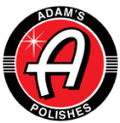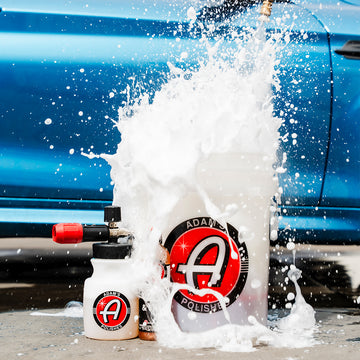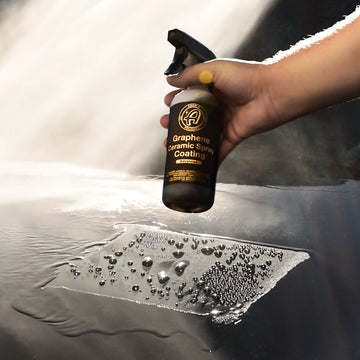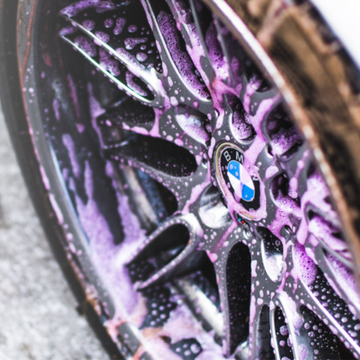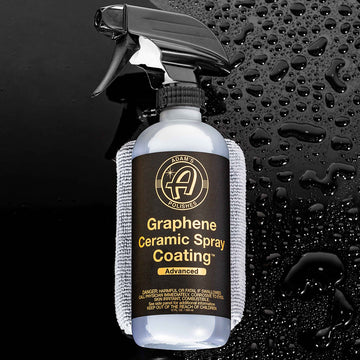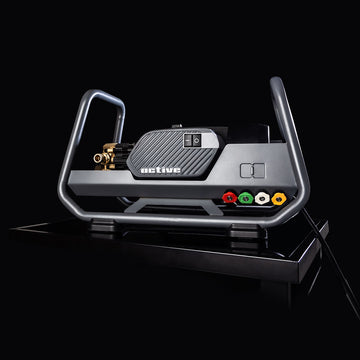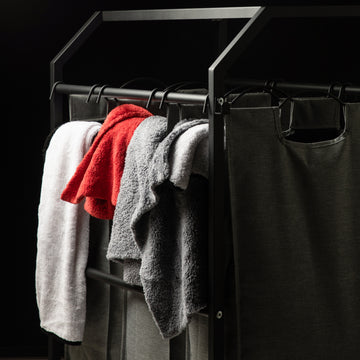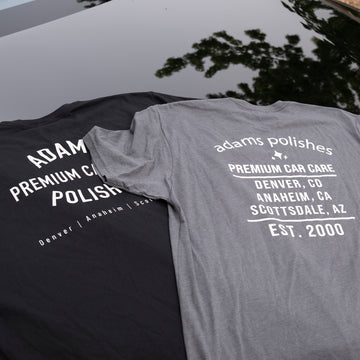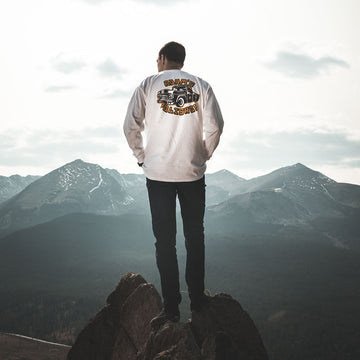The fall season has just begun, but now is the perfect time to start thinking about and preparing your car for possibly harsh winter driving and more difficult weather conditions; however, preparing your car for winter time can mean different things for different regions. The products and processes that you use will vary depending on your part of the country and the environment and climates that you experience during the winter months.
In the northeast, central plains, and midwest mountains, you will be driving through dangerous snow and icy conditions. In the pacific northwest, you will undoubtedly have to deal with heavy rain and colder temperatures. In dry, desert areas like parts of California, Arizona, and Nevada, and southern parts of the country like the Gulf Coast, your winter months are the time of the year where it’s cooling down enough to clean your car outside without dealing with very high temperatures and super hot sun beating down on you and your car. In this blog, we’ll detail the different ways to prepare your car for winter in three main climate types - (1) Snow and Ice Regions, (2) Dry and Desert Regions, and (3) Wet and Cold Regions.
Winter Prep In
Different Climates
Introduction
Snow & Ice Regions
Many parts of the country and world, for that matter, deal with large amounts of snow and ice for several months of the year - sometimes even before and after winter officially starts and ends. In areas such as Colorado, where our headquarters is located, we experience large snowfalls that can bring a foot or more of snow in under 24 hours. Plowing snow and treating roads during winter is critical for safety, and CDOT spends nearly $70 million dollars annually on snow removal alone, so that shows how important it is to keep drivers as safe as possible. Roads here are commonly treated with liquid Magnesium Chloride, or mag chloride, because it works in colder temperatures where rock salt and liquid salt are no longer effective. It is less harmful to the environment, but it can harm your vehicle’s finish, such as corroding chrome trim pieces - making them look spotted and stained.
In other parts of the country, such as Massachusetts in the northeast, roads can be treated with 5 different types of materials: mag chloride, rock salt, liquid brine (saltwater), pre-mix (rock salt and calcium chloride), and sand. Some other areas use coal ash and even small stones, called anti-skid, for traction on slippery roads. States around the Great Lakes such as New York, Pennsylvania, and Ohio can experience 40 or 50-degree temperature swings in one day during the winter, going from sunny and 60’s to rain to sleet to snow and temperatures dropping to 20℉ and lower, making it difficult to use some treatments like liquid salt, since it will freeze. Using a combination of these materials melt snow and ice to provide safer driving conditions, but they stick to your vehicle and can lead to frame and suspension rust, as well as rust on lower body panels, such as fender lips, bedsides, and tailgates. Sand and anti-skid can stick to the vehicle and then cause scratching when you go to wipe them away with a wash mitt.
Exterior Prep
The bottom line is that all of these road treatment materials can cause significant damage to your vehicle if you do not take care of them, so it is important to remove these contaminants from your car as soon as possible. Before the snow and ice arrives, take the time one weekend or a free evening to add a new layer of durable protection onto the vehicle that will last throughout the winter months. Whether your vehicle is already ceramic coated or brand new, Graphene Ceramic Spray Coating™ Advanced will greatly improve protection and water-repelling behavior, making it more difficult for winter contamination to stick to the vehicle. Thoroughly wash your car using our Car Shampoo or Mega Foam, rinse, then re-suds it down and decontaminate the surfaces with a Clay Mitt, focusing on areas that see the most wear when driving - bumpers, doors, rocker panels, windshield, and the trunk or tailgate. Adam demonstrates claying while washing in this video here: How To Properly Decontaminate A Vehicle With Clay
With the vehicle washed and decontaminated, now you are ready to apply Graphene Ceramic Spray Coating™ Advanced. You could polish the paint first to remove any imperfections, but you will most likely encounter some unavoidable light scratches or swirl marks during winter, so you can save time here by waiting to polish the paint after winter when the weather is much nicer. Use Surface Prep and a plush microfiber towel to remove any clay residue to ensure the surface is as clean and smooth as possible, and then you are ready to apply Graphene Ceramic Spray Coating Advanced. Apply the coating to one or two panels at a time by spraying in a Microfiber Applicator Pad, spreading it onto the surface, and allowing it to flash for a few minutes. As the coating begins to feel like it has a bit of tension or stickiness with your towel, and you see the oily rainbow appearance begin to dissipate and turn to a more clear finish, those are the main indicators to take your plush towels and wipe away the residue very thoroughly - wipe the panel more than you think you need to, in order to have minimal high spots to fix later. For a quick how-to video on application, click here: How To Apply Adam's Graphene Ceramic Spray Coating Advanced
Make sure to also do an extensive cleaning of your wheels, and apply the spray coating to them as well…road salt and mag chloride can be corrosive to certain wheel finishes and cause the clear coat to fail prematurely or stain certain colors. While coating the wheels, make sure your tire pressure is where it should be, since colder temperatures will usually cause your tires to lose a few pounds of air. Now is also a good time to top off any fluids in the engine bay - windshield washer fluid and coolant especially - and to change your oil if it is nearing the service interval for your car.
Interior Prep
You will be dragging large amounts of snow, slush, and dirt into your vehicle during winter, so the best way to protect things and make cleanup easier is to install some all-weather floor mats if your vehicle does not already have them. Graphene Ceramic Spray Coating Advanced can be applied to these floor mats and allows for easier cleaning of the floor mats without making them slippery. Some other optional interior prep would be to keep a bottle of Interior Detailer with Microban and an Edgeless Utility Towel inside to wipe down seats, armrests, and the center console if you have an accidental spill of coffee or hot chocolate. Keep a blanket and a bag of sand in the trunk or backseat in case of a traffic pileup on the highway, as well as a snow brush - but be very careful when using a snow brush not to brush all the way down to the paint, as this will definitely leave swirl marks and scratches in the vehicle’s finish!
Dry & Desert Regions
Judging by the previous section, preparing your car for winter when you live in a snowy or icy environment is arguably the most amount of work, but there are many areas of the country that never see snow or even freezing temperatures during the winter months. In dry or desert areas like Scottsdale and Las Vegas that can reach a scorching 120℉ in the summer months, the winter months are finally a chance to enjoy cooler, more comfortable weather, usually in the 50-70℉ range. This is the time of the year when car shows might be at their peak for these areas, and with that, it also means it’s a great time to take advantage of the more pleasant weather for more routine car washing!
You don’t necessarily have much to prepare for during winter months in desert regions, but it is the time of the year that you can maintain your car more easily. Dust and sand on your vehicles can be a constant reality in dry areas, so weekly Two Bucket Washes are a luxury that you have that many others may not be able to do because of freezing temperatures.
Exterior Washing
The Adam’s Daily Driver Detailing Kit is one suggestion we would make for dry and desert climates during the winter months. Add a second bucket with Grit Guard, a hose and water - or even better, a pressure washer and a Premium Foam Cannon - and you will have everything you need to effectively clean the outside of your vehicle. Always start your wash routine by cleaning the wheels and tires first. The reason we recommend this is so that hard-water spends as little time as possible on the paint and glass, where it can etch and cause water spots. Spray the Wheel & Tire Cleaner into the inner fender and then onto the tire and wheel. Use the Fender Brush to scrub the inner fender and tire, then the Wheel Brush and the Angled Wheel Brush to clean the outer face and inner barrel of the wheel respectively. Once you have one wheel and tire clean, then move onto the next - never let Wheel & Tire Cleaner dry onto any surface, and never spray it onto a hot surface!
With the wheels and tires now looking great, you can move onto washing the rest of the vehicle. If it’s a hot day in the winter, try to wash in the shade if possible, or during the early morning or evening hours. If this isn’t possible, wash the areas in the sun first from the top of the vehicle down, and then wash the shaded areas. Do not rinse the soap residue until you are finished with the entire vehicle. Our Mega Foam soap is pH neutral, and even if it begins to dry on the surface, it will rinse cleanly. This will help to prevent hard water spots as well. After rinsing everything, you can then quickly dry the vehicle with the Ultra Plush Drying Towel and then treat the paint and glass with CS3 and the Borderless Grey Towels included in the kit, to add considerable shine and 1-2 months of protection in a short amount of time. CS3 is also a great way to maintain your car, or to remove some light dust and fresh bug guts here and there throughout the week. Finish off the quick wash with Tire Shine, and you’re ready to head to your favorite cruise spot. Make sure to check out our full write-up on preparing your car for a car show at the link here: How To Get Your Car Ready For A Car Show
Interior Cleaning
Don’t forget about the interior! As the temperatures cool off, take this opportunity to do more of a deep-cleaning on the inside of your car as well. Vacuum out the interior - don’t forget to move the front seats all the way forward and backward to get everything possible. Scrub any all-weather floor mats with Rubber Mat & Liner Cleaner, and then deep clean any leather, plastic, and vinyl with Leather & Interior Cleaner and the Interior Scrubbing Mitt. The hot summer months can dry out leather and even fade the color of leather surfaces, so now is a good time to replenish the leather by keeping it soft, moisturized, and protected with Adam’s Leather Conditioner.
Wet & Cold Regions
Our final region type for preparing your car for the winter months are climate areas that have large amounts of rainfall and colder temperatures. These areas might see some snowfall, but rainstorms and fog are more common throughout the winter months than snow accumulation. Two examples of these types of conditions are Portland and Seattle, which average less than 7” of snowfall all winter, but see significantly higher levels of rain. We mentioned earlier that winter months in the Gulf Coast region are usually a good time to wash your vehicle since the very hot summer temperatures have gone down, but the Gulf Shores are also wet and rainy year-round, especially during summer and fall, which coincide with hurricane season. Heavy rainstorms can lead to dangerous driving conditions in multiple ways. They cause roads to become more slippery as the rain lifts oils out of the asphalt and pulls them up to the surface, they can cause flooding on roadways with poor drainage, and most importantly, they can greatly restrict outward visibility through the windshield during a downpour.
Graphene Glass Coating
Our Glass Sealant has been a favorite for years in its ability to repel water from glass once you reach highway speeds; however, it can wear away after approximately 200 miles of driving in the rain, or after a month or two of using the windshield wipers and windshield washer fluid. The wiper blades can wear away the sealant over time, and the washer fluids contain alcohol that can weaken the sealant layer as well, meaning you will have to apply it more frequently. With advancements in technology though, we now are able to offer a Graphene Glass Coating that has considerably better performance in repelling water, as well as extreme resistance to detergents like wiper fluid and abrasion from the wipers themselves. Graphene Glass Coating can last upwards of 9-12 months with one application, so it will last throughout the rainy season and more. Application is very easy:
- Move the vehicle indoors or into the shade. All the glass to cool off if it is warm or hot.
- Make sure the windshield is extremely clean before application by claying it with a clay bar and Glass Cleaner as the clay lubricant.
- Wipe away all residue with a clean Glass Towel. The cleaner the glass, the better the coating will adhere and bond to the surface.
- Apply the Graphene Glass Coating evenly to half of the windshield using a Gray Microfiber Applicator Pad. Apply in a left-right direction and then cross-hatch in an up-down direction to ensure full coverage.
- Unlike our Graphene Ceramic Coating for paint, there is no flash time necessary for Graphene Glass Coating, so you can wipe away the residue almost immediately. seconds before wiping away the
- You can let it set up for 20-30 seconds before wiping away the residue with an Edgeless Utility Towel. This will allow the coating to get down into the pores of the glass and bond better.
- Repeat for the other half of the windshield.
- Optional: Apply a second layer to the windshield to really make sure you have full coverage.
- Apply the coating to the remaining exterior glass using the same process as above.
You will notice that wiping away the residue from Graphene Glass Coating is very easy - it will almost seem like it wipes away too easily - much easier than our Glass Sealant. while offering better performance and much more durability. There is no cure time either like our Graphene Ceramic Coating options for paint, so you can drive the vehicle right away; however, you must make sure that the glass is not warm or hot before application. Apply Graphene Glass Coating on a nice day, out of direct sunlight, when the glass is cool, so that you do not have any issues with streaking or haze.
Dealing with Interior Fog
Rain and colder temperatures can also bring fog. The winter months will sometimes have more calm and cool conditions with low wind, which will trap moisture near the ground and create radiation fog. A similar reaction can occur with the windshield on your vehicle, where the cold exterior glass reacts with warm, moist air in the vehicle’s interior, and causes fog to quickly build up on both sides of the glass. Our Anti-Fog product is a cleaner that can be used on glass, mirrors, visors, lenses, and more, that leaves behind a hydrophilic coating film. In other words, it leaves a barrier on the surface that flattens water (or moisture) rather than beading it up, which reduces or eliminates fogging on the surface. One important thing to note is that the invisible coating film that Adam’s Anti-Fog leaves on the windshield will be removed if you wipe it later with a towel or use Glass Cleaner, so you may need to reapply multiple times throughout the winter season.
Summary
That wraps up another article in our educational series! In this blog, we discussed different climate regions and the various methods and products that you can use to prepare your car for the winter months in each of these three key areas. For snow and ice regions, we recommend adding or re-adding a layer of Graphene Ceramic Spray Coating™ Advanced for easier removal of snow and more protection against harsh road treatment chemicals and materials. For warmer locations such as dry and hot desert regions that do not experience as cold of temperatures during winter, we explained how it is the perfect time of the year to do routine washes and interior cleaning. And finally, in wet and cold regions that deal with much more rainfall than snow or ice, we explained how treating and protecting the vehicle’s glass with Graphene Glass Coating and Anti-Fog will provide better visibility and improved safety in dangerous heavy rain driving. If you are uncertain about any product or process, or have any questions in general, feel free to contact us at tips@adamspolishes.com, or reach us on our online communities on adamsforums.com, Instagram, and Facebook, as well.
